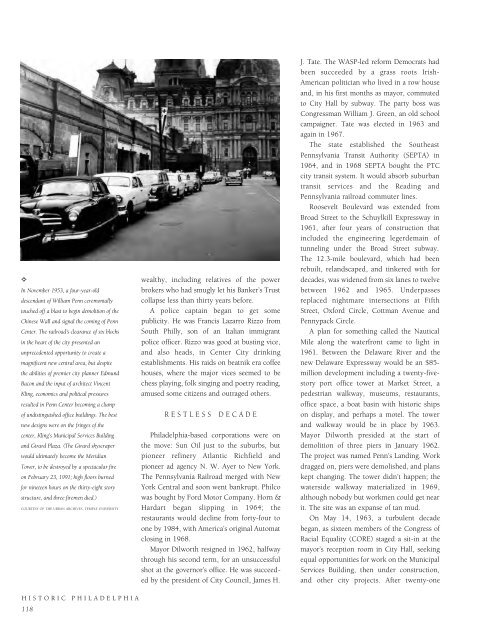Historic Philadelphia
An illustrated history of the city of Philadelphia, paired with the histories of companies, families and organizations that make the region great.
An illustrated history of the city of Philadelphia, paired with the histories of companies, families and organizations that make the region great.
Create successful ePaper yourself
Turn your PDF publications into a flip-book with our unique Google optimized e-Paper software.
✧<br />
In November 1953, a four-year-old<br />
descendant of William Penn ceremonially<br />
touched off a blast to begin demolition of the<br />
Chinese Wall and signal the coming of Penn<br />
Center. The railroad’s clearance of six blocks<br />
in the heart of the city presented an<br />
unprecedented opportunity to create a<br />
magnificent new central area, but despite<br />
the abilities of premier city planner Edmund<br />
Bacon and the input of architect Vincent<br />
Kling, economics and political pressures<br />
resulted in Penn Center becoming a clump<br />
of undistinguished office buildings. The best<br />
new designs were on the fringes of the<br />
center, Kling’s Municipal Services Building<br />
and Girard Plaza. (The Girard skyscraper<br />
would ultimately become the Meridian<br />
Tower, to be destroyed by a spectacular fire<br />
on February 23, 1991; high floors burned<br />
for nineteen hours on the thirty-eight story<br />
structure, and three firemen died.)<br />
COURTESY OF THE URBAN ARCHIVES, TEMPLE UNIVERSITY.<br />
HISTORIC PHILADELPHIA<br />
118<br />
wealthy, including relatives of the power<br />
brokers who had smugly let his Banker’s Trust<br />
collapse less than thirty years before.<br />
A police captain began to get some<br />
publicity. He was Francis Lazarro Rizzo from<br />
South Philly, son of an Italian immigrant<br />
police officer. Rizzo was good at busting vice,<br />
and also heads, in Center City drinking<br />
establishments. His raids on beatnik era coffee<br />
houses, where the major vices seemed to be<br />
chess playing, folk singing and poetry reading,<br />
amused some citizens and outraged others.<br />
RESTLESS<br />
DECADE<br />
<strong>Philadelphia</strong>-based corporations were on<br />
the move: Sun Oil just to the suburbs, but<br />
pioneer refinery Atlantic Richfield and<br />
pioneer ad agency N. W. Ayer to New York.<br />
The Pennsylvania Railroad merged with New<br />
York Central and soon went bankrupt. Philco<br />
was bought by Ford Motor Company. Horn &<br />
Hardart began slipping in 1964; the<br />
restaurants would decline from forty-four to<br />
one by 1984, with America’s original Automat<br />
closing in 1968.<br />
Mayor Dilworth resigned in 1962, halfway<br />
through his second term, for an unsuccessful<br />
shot at the governor’s office. He was succeeded<br />
by the president of City Council, James H.<br />
J. Tate. The WASP-led reform Democrats had<br />
been succeeded by a grass roots Irish-<br />
American politician who lived in a row house<br />
and, in his first months as mayor, commuted<br />
to City Hall by subway. The party boss was<br />
Congressman William J. Green, an old school<br />
campaigner. Tate was elected in 1963 and<br />
again in 1967.<br />
The state established the Southeast<br />
Pennsylvania Transit Authority (SEPTA) in<br />
1964, and in 1968 SEPTA bought the PTC<br />
city transit system. It would absorb suburban<br />
transit services and the Reading and<br />
Pennsylvania railroad commuter lines.<br />
Roosevelt Boulevard was extended from<br />
Broad Street to the Schuylkill Expressway in<br />
1961, after four years of construction that<br />
included the engineering legerdemain of<br />
tunneling under the Broad Street subway.<br />
The 12.3-mile boulevard, which had been<br />
rebuilt, relandscaped, and tinkered with for<br />
decades, was widened from six lanes to twelve<br />
between 1962 and 1965. Underpasses<br />
replaced nightmare intersections at Fifth<br />
Street, Oxford Circle, Cottman Avenue and<br />
Pennypack Circle.<br />
A plan for something called the Nautical<br />
Mile along the waterfront came to light in<br />
1961. Between the Delaware River and the<br />
new Delaware Expressway would be an $85-<br />
million development including a twenty-fivestory<br />
port office tower at Market Street, a<br />
pedestrian walkway, museums, restaurants,<br />
office space, a boat basin with historic ships<br />
on display, and perhaps a motel. The tower<br />
and walkway would be in place by 1963.<br />
Mayor Dilworth presided at the start of<br />
demolition of three piers in January 1962.<br />
The project was named Penn’s Landing. Work<br />
dragged on, piers were demolished, and plans<br />
kept changing. The tower didn’t happen; the<br />
waterside walkway materialized in 1969,<br />
although nobody but workmen could get near<br />
it. The site was an expanse of tan mud.<br />
On May 14, 1963, a turbulent decade<br />
began, as sixteen members of the Congress of<br />
Racial Equality (CORE) staged a sit-in at the<br />
mayor’s reception room in City Hall, seeking<br />
equal opportunities for work on the Municipal<br />
Services Building, then under construction,<br />
and other city projects. After twenty-one
















